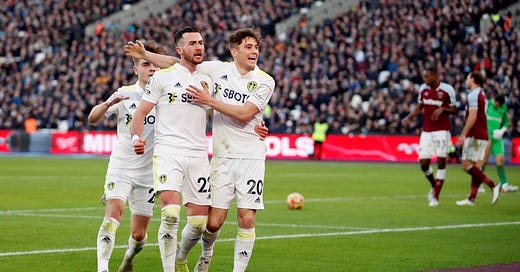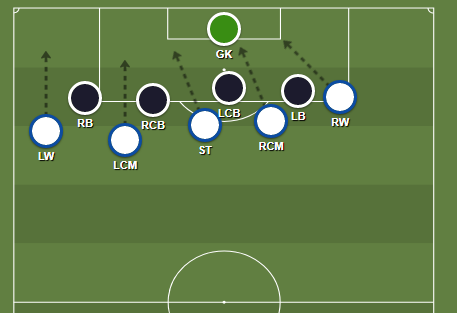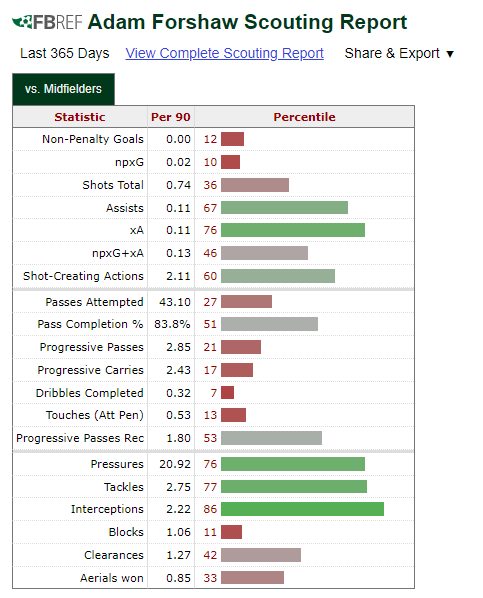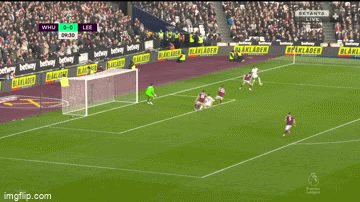Hello and welcome to the first All Stats Aren’t We newsletter of 2022. Each month we discuss stats, players, and tactical aspects that have caught our eyes during the games over the last few weeks. This month Tom Alderson takes a look into Luke Ayling’s progressive numbers so far this season, Jon Mackenzie discusses whether Adam Forshaw would have made a difference against Newcastle, and Adam Elliott focuses on the All Stats Aren’t We poster boy himself: Adam Forshaw.
Stats Analysis
A closer look at Luke Ayling’s progressive numbers so far this season
If you’ve been a keen reader of All Stats Aren’t We articles over the past couple of seasons, you will know that I like to keep a keen eye on Luke Ayling’s progressive numbers because he is so key to Leeds United’s ball progression.
This season we have mentioned on the podcast how Leeds struggled to progress the ball when Ayling was out injured, but also that even when Ayling has played this season he hasn’t been able to progress the ball as well as he has previously, mainly due to injury. I therefore thought I’d dig into the numbers to see if they backed up our views. These stats are shown below, corrected to per 90 minutes and with low minutes players removed. The players rank within the Leeds team is shown in brackets.
If we look at Ayling’s Progressive Passing first, we can see that whilst his Progressive Passing is slightly down, his Progressive Passing distance is actually up. Where the real differences are seen in Ayling’s progression is in his Progressive Carrying. Last season Ayling was averaging 6.14 Progressive Carries, which is down to 4.42 Carries this year. His Progressive Carrying distance was also down, from 218.1 Yards per 90, to 190.80. His rank within the Leeds team has also fallen from last season to this season.
There are a few possible explanations for these differences. The first is due to the Leeds playing more transitionally this year compared to last year, meaning that Ayling may find himself passing out from the back rather than carrying the ball out when Leeds are in a more set attacking shape during settled possession. The more transitional nature of Leeds’ play may also explain why Ayling’s Progressive Carries ranks within the Leeds team have dropped, as different players are progressing the ball rather than Ayling.
The second could simply be due a drop in form following Ayling’s and Leeds’ amazing form over the three previous seasons. There were rumours Ayling was carrying an injury earlier in the season which contributed to his drop in form (although this was never confirmed), but even so it would have been difficult to carry on his form from last year as he ranked in the 99th percentile for Progressive Carrying Distance for Full Backs, compared to a still respectable 91st percentile this year.
If now we focus on the impact Ayling has on Leeds’ progression; Leeds’ Progressive Carrying Distance is plotted on the chart below, with the dotted line showing a 5-game moving average. The red lines indicate when Ayling first got injured, and then when Ayling returned from injury.
Leeds actually started the season fairly well carrying the ball progressively. Ayling contributed to this by posting above 200 Progressive Carrying yards in 3 of the first 5 games.
As we can see looking at the graphic above, Leeds’ progressive carrying numbers fell after Ayling’s injury. Losing Ayling’s ability to carry the ball out from the back had a negative impact on Leeds’ Progressive Carrying numbers.
The numbers didn’t recover after Ayling’s return from injury as he struggled to get back up to speed, as he has failed to record above 200 yards of Progessive Carrying at any point since his return.
However, there were signs against Newcastle that Ayling was getting back to his best, with this helping Leeds to record their highest Progressive Carrying Distance of the season, and Ayling recording his highest Progessive Carrying distance since his return. Leeds fans will be hoping that this is a sign of things to come from Ayling as he is crucial to Leeds’ style of play.
I know we don’t like to talk about a post Bielsa life at Leeds, however we get asked a lot at All Stats Aren’t We who we think would be the best replacement. Jon has started a Bielsa Successor series where this month he looked at Andoni Iraola. Why not check it out below?

Tactics Discussion
Would Adam Forshaw have made the difference against Newcastle?
With the dust settling around Elland Road after a disappointing loss to Newcastle, Marcelo Bielsa was being interrogated by the media. In particular, they wanted to know if the loss of Adam Forshaw the week before at the London Stadium had been the difference between the two sides.
Bielsa was uncompromising in his reply: “No, the role of Forshaw, Klich occupied it today. And at the end of the game we had two offensive midfielders who had the capacity to unbalance like Tyler and Rodrigo, with five players in front. I don’t think the characteristics of Forshaw would have improved this situation. Because Tyler and Rodrigo are players who have the characteristic to find that final pass and also to receive it. Forshaw is the player who links himself between our defensive mid and our attacking mid but less with our number 9.”
Forshaw himself had been watching the game from the gantry at Elland Road, fulfilling his media obligations by appearing on LUTV as a color commentator. Where Bielsa saw the solution to the gamestate being players who had “the capacity to unbalance like Tyler and Rodrigo” rather than “the player who links himself between our defensive mid and our attacking mid”, Forshaw took a slightly different view. “As counterproductive as this sounds, I think we need to be slower in the build up. As we go long, we’re hitting people who aren’t good in the air. We need to realise there are three or four minutes left and as much as it sounds like [we’d be] slowing the build up, it’s not going to work any other way.”
Of course, there isn’t a complete dissonance here between Bielsa’s approach and Forshaw’s. In response to Tony Dorigo’s complaint about there being no midfield — “What’s going on with the midfield? Well, there is none.” — Forshaw had pointed out that this has been Bielsa’s plan all along: the games where Leeds are transitional and it works are left unremarked upon… it’s only the ones where it doesn’t work where it is pointed out. Forshaw’s “slower tempo” could be married to Bielsa’s players with “the capacity to unbalance”. But fans of Leeds during the Bielsa era will know the numbing inevitability of those games where Leeds have to break down deeper lying defences and so any alternative solutions to the problem beyond Bielsa’s would seem welcome.
The lack of a midfield question that Dorigo highlighted is a regular refrain from Leeds fans. At times, the gaping hole in the heart of the Leeds midfield is conspicuous — not least when opposition players run through it seemingly unopposed. But Forshaw is right to point out that this is the plan.
In possession, Leeds adopt an approach that is loosely termed “positional play”. There have been complaints about this label because it is a catch-all term that often seems to escape clear definition. Usually, it is described as being a way of fashioning “superiorities” — which are basically player overloads or manipulations of space to allow a team to achieve spatial or territorial advantages. In practical terms, you’ll know these as “third-man runs” or “overloading to isolate” scenarios where Leeds build up on one side to draw in the opposition to then release the ball to the other side of the field where a player is under less pressure in a 1v1.
One facet of this positional play is about arriving in the box with the ball and players in dangerous situations able to profit from it. Last season, Leeds were one of the best performers for players in the box per box entry: a metric they have performed poorly in this season. The general principle is this: you need to look for the spaces between opposition back lines to be able to attack them. Here’s what it might look like against a back four when a team is attacking down the left hand side:
As you can see, there are five channels to attack against a back four: the space between the centre backs, the full backs and the centre backs, and the full backs and the sideline. With a front three, you can cover three of those channels. The other two have to be covered by your ball-near full back or the two centre midfielders. If both centre midfielders go forward, then you only have one midfielder, the defensive midfielder, left to patrol the whole of the midfield.
When you add in the game state — Leeds are one goal down at home against Newcastle — the opposition are going to sit in and try and deny you space, making it hard for you to generate dangerous chances. The issue here isn’t progressing the ball down the field — the opposition will let you do that fairly easily — the issue is generating chances. Here’s what the setup looked like at points in the last 20 minutes against Newcastle:
In this situation, you’re not too worried about the opposition counter-attacking because you’re losing anyway. So you want to keep your midfielders attacking those spaces between the opponent’s back line with creative players around to exploit those gaps. This was why Bielsa wanted Tyler Roberts and Rodrigo on: two of his most creative options. Adam Forshaw is more about ball progression through the thirds and so would have been wasted in this sort of scenario.
Perhaps Forshaw is right. Maybe Leeds needed more patience to work an opening. But that doesn’t mean that Forshaw himself would have been the solution. Yes, he might have allowed Leeds to hold onto the ball longer. But was that really the issue? Surely the issue was that Leeds didn’t have the creativity to fashion good chances? The issue against Newcastle was less a lack of midfield, then, but rather a lack of low-block creativity to break the opposition down.
If you want to learn more about how Newcastle caused Leeds problems in the latest game, why not check out the video below over on our Patreon?

Player Focus
A closer look at the All Stats Aren’t We’s prodigal son
Out for two years? Not a problem for the All Stats posterboy. The midfielder was labeled the best player at the club during Bielsa’s first look at the squad in pre-season 2018, and it’s easy to see why given a number of eye-catching performances since his remarkable return from such a long and testing injury. An absence of such length could be the end for a lot of players, particularly due to the physical and mental impact it leaves. There were some question marks over retirement; but, aside from, in his own words, a minor hamstring injury sustained against West ham, he is so far proving his body can hold up and long may that continue.
But what is it exactly that makes him so good? Let’s take a closer look.
Personally, I am shocked that he has been able to be at this level; the mental toughness to come back and look every part a Premier League midfielder is truly exceptional. Forshaw is a high intensity player who presses intelligently without the ball, but protects the ball superbly when he has it. As Jon discussed earlier, the loss to Newcastle was evidence of the size of the hole in midfield without him. He has made the position his own and made himself undroppable. As part of the LUTV commentary team Forshaw remarked, “I think we need to be slower in build up.” Reading between the lines he was explaining how the midfield could be better - if he was in it.
The ability to change tempo, either to slow things down or speed up attacks, is one of the most important for a midfielder to have; this, combined with the passing angles Forshaw creates for his teammates (particularly to full-backs and centre-backs) are what makes him essential in this Leeds team. Jon likes to use the term chaos-ball to describe some of Leeds’ games this season, but with Forshaw in the team Leeds can play a more possession based style than regularly transcending into a transitional game with lots of counter-attacks. One minute he can look for sharp one-and-two touch passes more laterally, and the next he’s knocking it around safely more horizontally. Too safe? Too pedestrian. No. His ball retention and smart passing is essential at times to get us into shape and rhythm; he can be the heartbeat of our midfield.
The data on FBref below shows the defensive work he is helping to get through most of all. However, it is perhaps not reflective of some of his abilities with regards to shielding and keeping the ball. His agility and balance is far superior to Kalvin Phillips, meaning he is able to play through situations by simply having a smaller turning circle and centre of gravity. This press resistance also gives him an advantage over Phillips in the holding role when has been deployed there. When Phillips is pressed a lot, it can unbalance him and render him less effective in possession, but this is unlikely to affect Forshaw and he can thrive even in high stress situations.
His ability to keep composure and get out of these high pressure situations can be seen in the clip below. This is something no other midfielder in our squad does better.

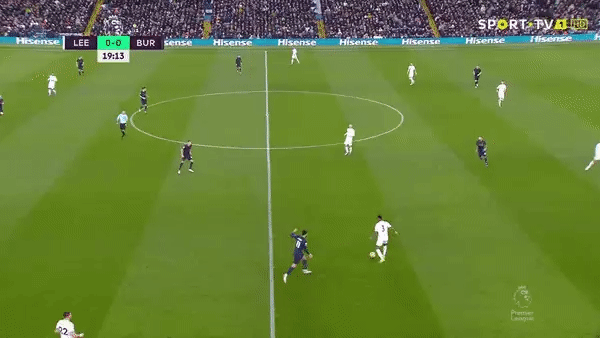
It is not just quality in build up with tempo, and his press resistance that set him apart, though; it is also his speed of thought and awareness of his surroundings. Another trait which sets midfielders apart is the ability to scan before receiving the ball. In the clip below, Forshaw is aware of the situation before the opposition have time to react. Many players in this scenario would choose to take more time to assess, run into traffic, or even shoot themselves. Forshaw is aware of Harrison’s position and instantly gives him a simple, yet highly effective, pass for the goal. Simple, effective, efficient.
His role in this Leeds team cannot be stated enough. He has become essential and this was shown with good faith from the club two weeks ago when he signed a contract extension to June 2023, a reward for all his hard work and impressive performances. Not many clubs would have given a man so seemingly perennially injured this sort of chance. We got this one right.
Forshaw has been the player of the last two months, but if he can stay fit, and continue to play like this, then the hope is Leeds will survive relegation fairly comfortably and he will surely take home the player of the season award. Another high quality midfielder this month to partner him, and Leeds would finally have the balance in midfield required to be more solid, and less chaotic, and thus be playing top flight football in 2022/2023.
Why not join our Discord and discuss all things Leeds United with other fans?

If you enjoy this content and want to help us create more and better pieces, why not consider signing up to our Patreon page to get bonus material?
You can read more of our pieces over on our Medium page.
Get in touch with us @AllStatsArentWe if you have any interest in writing for us.
If you liked this post from All Stats Aren't We, why not share it?
